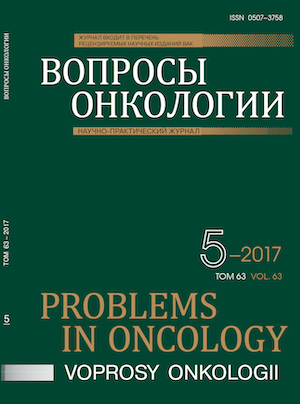摘要
Злокачественные опухоли, диагностируемые в полости рта, - это преимущественно различные виды плоскоклеточного рака (95 % от всех злокачественных опухолей данной локализации). Трудности диагностики и лечения обусловлены особенно сложной анатомической структурой полости рта, которая формируется с участием многих органов и тканей. Наиболее частыми локализациями злокачественных опухолей слизистой оболочки полости рта являются язык - 55 %, слизистая оболочка щеки - 12 %, дно полости рта - 10 %, альвеолярный отросток верхней челюсти и твердого неба - 9 %, альвеолярный отросток нижней челюсти - 6 %, мягкое небо - 2 %. Злокачественные опухолевые клетки несут на своей поверхности лиганды PD-L1, причем уровень его экспрессии нередко коррелирует с неблагоприятным прогнозом, в частности, при таких опухолях как меланома, рак почки, немелкоклеточный рак легких (НМКРЛ). Актуальной представляется оценка корреляции между избыточной экспрессией PD-L1 и общей выживаемостью у пациентов со злокачественными опухолями слизистой полости рта.
参考
Chen D.S., Irving B.A., Hodi F.S. Molecular pathways: next-generation immunotherapy-inhibiting programmed death-ligand 1 and programmed death-1 // J. Clinical Cancer Research. - 2012. - Vol. 18. - P. 6580-6587.
D'Incecco A. et al. PD-1 and PD-L1 expression in molecularly selected non-small-cell lung cancer patients // British J. Cancer. - 2015. - Vol. 112. - P 95-102.
Ferris R.L. Immunology and immunotherapy of head and neck cancer // J. Clinical Oncology. - 2015. - Vol. 33. - P 3293-3304.
Konishi J. et al. B7-H1 expression on non-small cell lung cancer cells and its relationship with tumor-infiltrating lymphocytes and their PD-1 expression // J. Clinical Cancer Research - 2004. - Vol. 10. - P 5094-5100.
Lipson E.J. et al. PD-L1 expression in the Merkel cell carcinoma microenvironment: association with inflammation, Merkel cell polyomavirus and overall survival // J. Cancer Immunology Research. - 2013. - Vol. 1. - P 54-63.
Mu C.Y et al. High expression of PD-L1 in lung cancer may contribute to poor prognosis and tumor cells immune escape through suppressing tumor infiltrating dendritic cells maturation // J. Medical Oncology. - 2011. - Vol. 28. - P. 682-688.
Ock C.Y et al. Pan-cancer immunogenomic perspective on the tumor microenvironment based on PD-L1 and CD8 T cell infiltration // J. Clinical Cancer Research. -2016. - Vol. 22. - P. 2261-2270.
Partlova S. et al. Distinct patterns of intratumoral immune cell infiltrates in patients with HPV-associated compared to non-virally induced head and neck squamous cell carcinoma // J. Oncoimmunology. - 2015. - Vol. 4. - e965570.
Song M. et al. PTEN loss increases PD-L1 protein expression and affects the correlation between PD-L1 expression and clinical parameters in colorectal cancer // PLoS One. - 2013. - Vol. 8. - e65821.
Taube J.M. et al. Colocalization of inflammatory response with B7-h1 expression in human melanocytic lesions supports an adaptive resistance mechanism of immune escape // Science Translation Medicine. - 2012. - Vol. 4. - 127-137.
Teng M.W., Ngiow S.F., Ribas A., Smyth M.J. Classifying cancers based on T-cell infiltration and PD-L1 // J. Cancer Research. - 2015. - Vol. 75. - P. 2139 -2145.
Vassilakopoulou M. et al. Evaluation of PD-L1 expression and associated tumor-infiltrating lymphocytes in laryngeal squamous cell carcinoma // J. Clinical Cancer Research. - 2016. - Vol. 22. - P. 704-713.

This work is licensed under a Creative Commons Attribution-NonCommercial-NoDerivatives 4.0 International License.
© АННМО «Вопросы онкологии», Copyright (c) 2017
